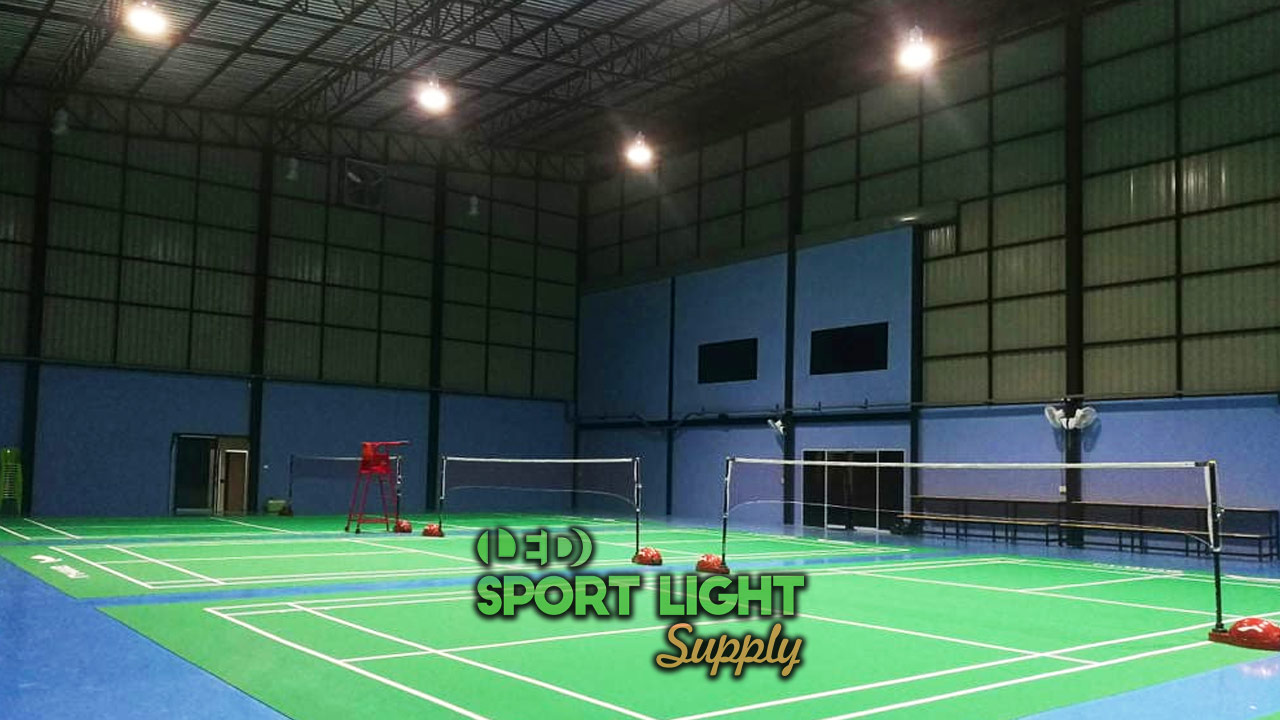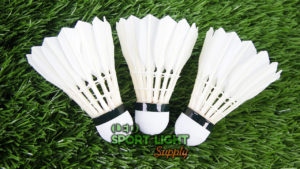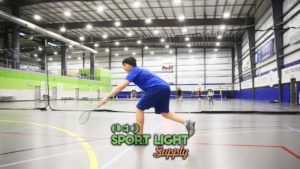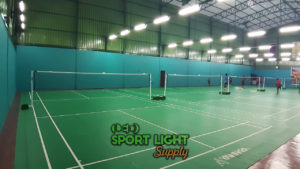Lighting a badminton court, no matter where it’s located; needs to have plenty of uniformity for light coverage. But one new advantage is the addition of LED lights that makes it possible to replace older style lights. Among some of these improvements includes the addition of improved CRI, Color temperature, and Lux standards. Now more than ever before, badminton courts are taking advantage of photometric lighting design.
This allows LED lights to have appropriate angles, light bounce, and luminous efficiency. To get a better idea of how lighting a court works using ceiling lights or lights on poles, please read further. This guide will best serve as the best ultimate view of badminton court lighting design. You’ll have a better understanding of how LED lighting works and how it can work better for your court also.
What kind of lights do Badminton courts use?
1. Flood light for badminton court
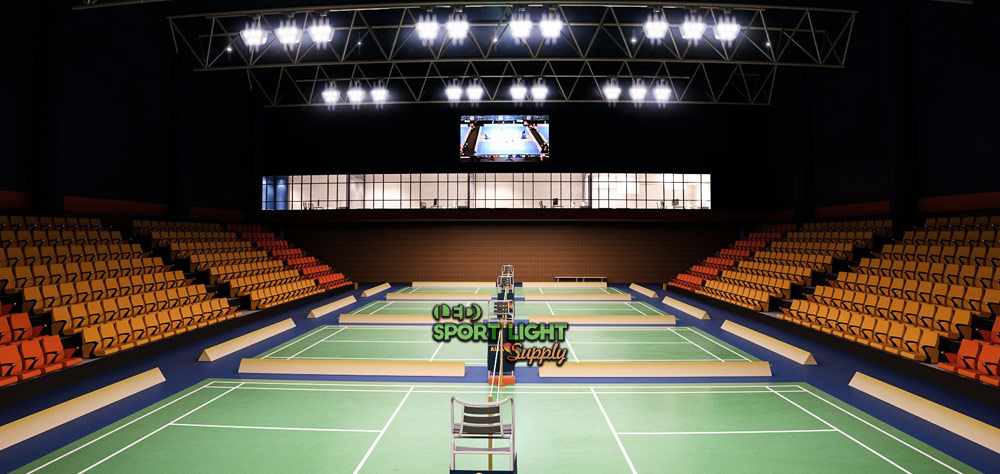
Your badminton court needs flood light to distribute the highest amount of light that can fill a court. Therefore the number of lights will vary depending on your court design. Both indoor and outdoor badminton courts use flood light but in very different ways. Outdoor lights are placed on poles largely because there’s no structure available to hang them from a roof. If there’s a structure that’s built-over the court for hanging these lights, then this is possible.
Indoor lights are used to take advantage of a prebuilt structure and can bounce light off the ceiling to maximize the light uniformity. Mostly these lights are pointed downward while many are angled to reduce shadow effects. Flood lights are practical since these give a select amount of candle lights per square foot for Lumen capacity. The more professional a badminton game is, also determines how strong the light is required to be.
2. UFO LED high bay light
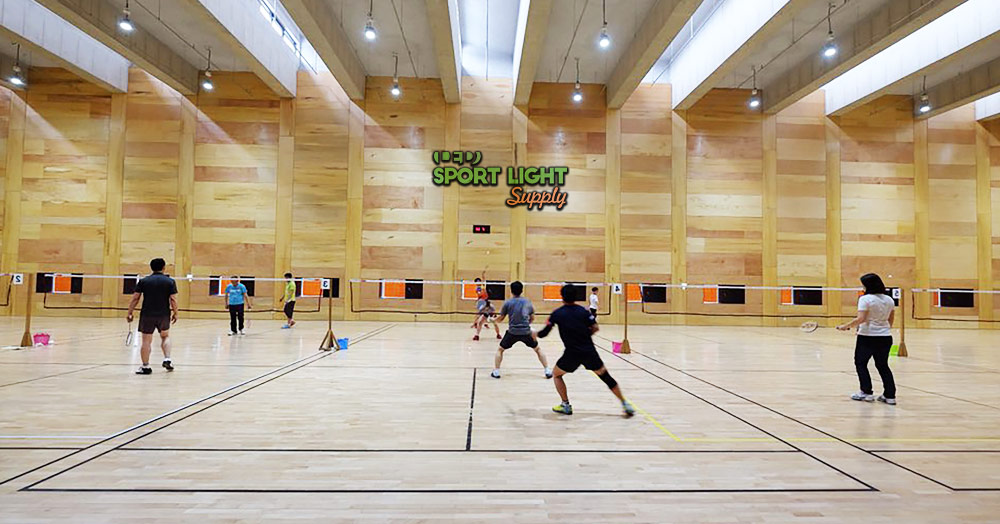
So what is this name trying to describe when they’re talking about UFO lights? If you’ve ever seen what the classic UFOs look like, it’s a classic flying saucer disc with a little dome on top. These are special indoor flood lights that are hung from above. The reason they work so well is that it gives a wide angle of illumination that’s good for court lighting. These angles include various degrees so the overhead flood lights cover large patches of the court.
These can include 60 degrees, 90 degrees, or 120 degrees and are varied by their angle depending on ceiling height. This keeps the light from straying outside the intended lighting path but is also used in combination with side lighting. As most UFO high bay lights provide adequate overhead lighting, they lessen shadows that corner lighting can cause. After this, the shadows that are directly underneath badminton players get fill-in light that removes this further.
3. Spotlights
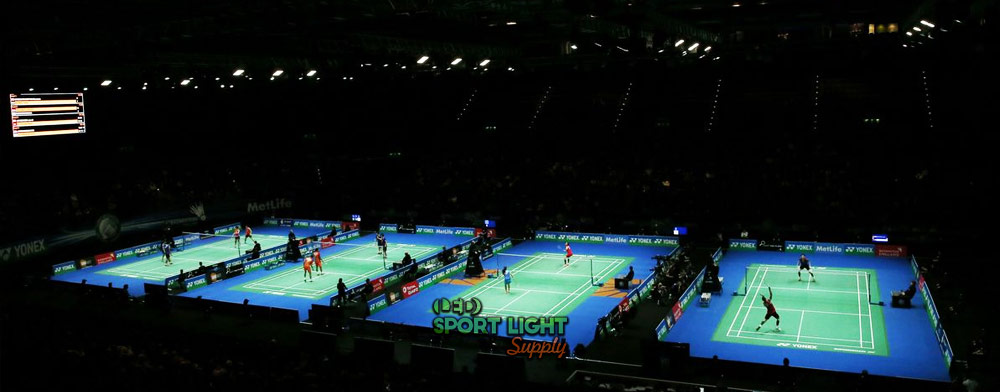
When you hear the spotlight it’s easy to get the impression that this is a narrow beam of light. What this light actually is used for is the fill light that’s meant for indoor badminton courts. These lights are angled along the upper edges of the ceiling. These are only used for competitions where professional matches take place. You’ll also find this is more attractive for television since these lights help to illuminate players.
Shadows that form from overhead bay lights bring shadows downward. With these floodlight spots, faces and uniforms have less shadowing. Even the shadows under the player’s feet are reduced to light reflections. For spectators that watch a match under this lighting, it’s easier to see all the little details. These lights also make it easier for coaches and judges to see and call on certain plays or penalties. It can also be useful for training purposes where certain defensive moves or movements are perfected.
4. High mast lights
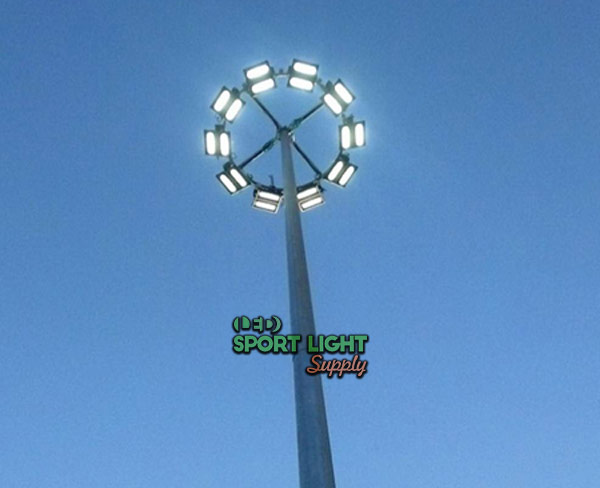 High mast lights are placed on light poles that must be used outside. Since these mast lights are put in the corners of the badminton court, there are often 4 of the light poles. Naturally, some outdoor courts will add extra light poles. This means that a 4-pole set-up turns onto a 6-pole or 8-pole setups. These are poles that are set onto the sides of a court that act as fill lights.
High mast lights are placed on light poles that must be used outside. Since these mast lights are put in the corners of the badminton court, there are often 4 of the light poles. Naturally, some outdoor courts will add extra light poles. This means that a 4-pole set-up turns onto a 6-pole or 8-pole setups. These are poles that are set onto the sides of a court that act as fill lights.
These lights also brighten the light levels for professional competitions up to the requirements of national and international championships. With each of the badminton courts and size variants, the height of the pole will change as well. As the pole height is raised, the more that this light is adjusted for height and distance differences. Since there can be potentials for light loss, the amount of Lumens is increased using a mathematic model. This formula helps badminton court owners estimate Wattage and Lumens needed.
Indoor badminton court lighting design and layout
1. Direct or indirect lighting
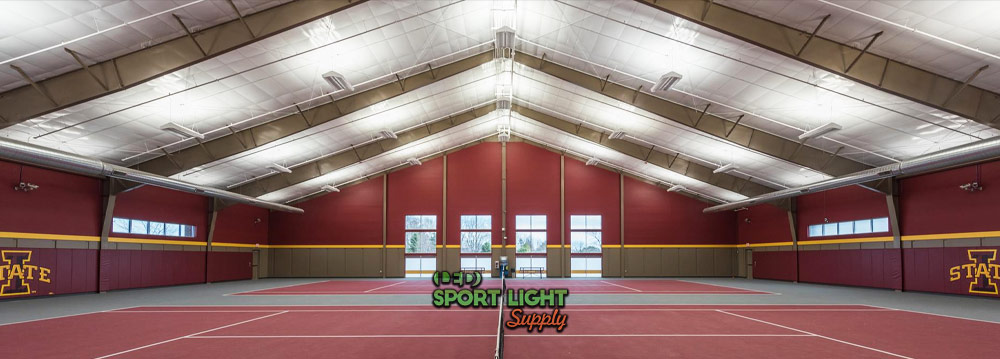
Here’s how this indoor lighting method works. When using indirect lighting, this means the flood lights point upward to the ceiling. As the light is bounced off the ceiling, the reflected light is bounced back down to illuminate the badminton court. This is used so the lighting uniformity is improved. It also provides a softer form of lighting that isn’t as harsh as direct lighting design.
But the problem is that this consumes too much energy because of the light loss from the reflection. Direct lighting is when you have your lights pointed down onto the badminton court. Using direct lights, the amount of Lumens needs to be determined beforehand so you know how much light will illuminate the court. Because it’s often easier to calculate direct light, you see this arrangement used more often.
The calculations needed for light intensity on indirect lighting depends on variables such as ceiling angle and so on.
2. Ceiling height of badminton hall
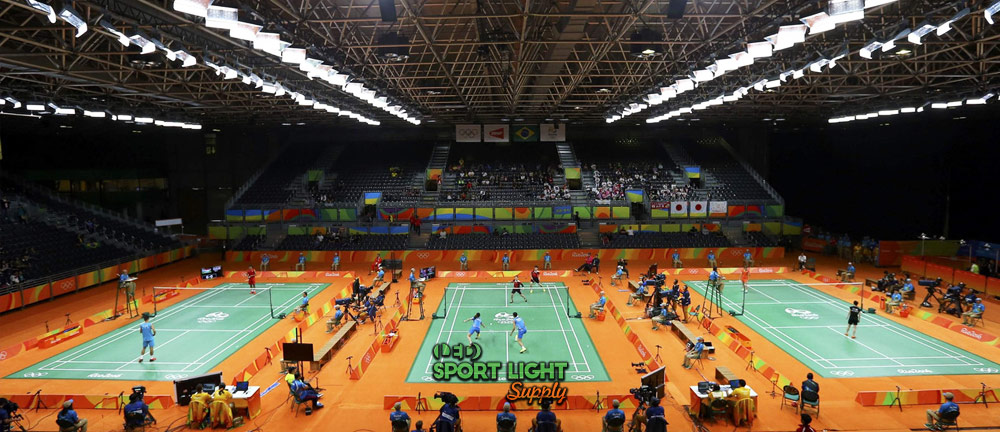
If there is a case where the ceiling height is not very high, you’ll need a larger beam angle. Then the light beam can be spread more before it hits the ground. If the ceiling height is too high, then the need for a smaller beam angle. This is why the need for a photometric (DIALux) study is used, so this helps to estimate the layout design. This study takes into consideration the height of a ceiling and this helps determine the beam angle.
This allows the most light to be spread out over the court floor. Taller ceilings will of course need narrow angles since the distance spreads out from the height. Lower ceilings need wider angles. These angles based on ceiling height all calculate what kinds of LED flood lamps are needed. After that, the number of Lumens, color temperature, and Wattage is decided as well. Then the installation follows when these lights are purchased.
3. Reflective index of the wall, ceiling, or floor
Indoor building all have a painted surface that will react from reflectivity. Some paints reflect better than others but the color also plays a large role. Some colors used for indoor rooms need to be light so the reflection doesn’t absorb. Dark-colored walls aren’t recommended since this can suck-in light as a result. Even the color of the floor can be problematic if natural wood is used.
Certain wood flooring can also suck up light if the surface is natural wood. This is why a professional court has a painted surface such as a green or blue with the court line layout painted on. It helps players see boundaries better. The walls and ceiling should be painted with light colors so that light can reflect easier. This is only needed if you plan on having indirect lighting. Using direct downlights doesn’t call for this, but it wouldn’t hurt either.
4. Distance between the LED lights in badminton court ceiling
For larger indoor badminton courts you’ll need to estimate the ceiling height first. This can be anywhere between 5-15 meters depending on the number of fixtures required. This is all due to the mounting heights and beam angle of your lights. With a higher ceiling, you’ll need to arrange these hanging lights so the beam angles work according to the total height of the ceiling. As the roof is higher or lower, the number of lights can increase or decrease.
Higher ceilings will need more lights while lower ceilings need fewer lights. The beam angle can then begin to fill in the amount of space on your court. These are easier to factor using a DIALux photometric study to show how many lights are needed. If your court is being used for professional competitions, you’ll likely add fill-in lights too. This will need an arrangement plan for your DIALux study also.
5. Beam angle
When using any kind of flood light that has a specific beam angle, ceiling height determines which angle is best for your court. Common beam angles include 25, 40, 60, 90, 120 degrees for many LED flood lights. The lower the number of degrees used is meant for high ceilings. When you have a higher number, this is used for low ceilings. 120 degrees is considered the best for low ceilings as the angle has optimal coverage.
As a narrow beam angle such as 25 to 40 degrees is used, it takes time for that angle to spread out using height. If you don’t estimate the ceiling height first, this can lead to buying more lights because of wrong beam angles. But this also doesn’t mean that higher ceilings will need fewer lights either. An overhead lighting diagram layout will show in the DIALux study how ceiling height adds or decreases overhead lights.
6. Heat emitted by the LED lights
If you’ve ever stood underneath older style HID or HPS lights, you can feel how much heat comes from them. This is why LED lights became a better alternative when it comes to replacing old lights. Using LED is better than HID, as it gives off less heat and saves on air conditioning costs. You also don’t have to worry about players getting overheated faster due to throw-off heat.
LEDs run very low in their heat that’s emitted and have special heat sinks built into their design. This in turn lets heat escape upward with no heat that’s pushed down. When larger tournaments are played and have spectators gathered, the use of air conditioning isn’t as much either. This is a cost-effective quality of LED light that further allows lower maintenance costs just for comfort issues.
And then, there are no more complaints of hot lights bothering spectators and athletes.
7. Number of LED light needs
Indoor lighting is problematic because most buildings don’t incorporate enough windows for the overhead light. There can be too few side windows to let in light as well. It all depends on the arrangement of windows in your badminton complex. If there is available light that can light up a court, you don’t need to turn on all the lights in the daytime. But that’s only if there’s sufficient sunlight.
It can be an option to use half of the lights if there is outside light available. Not that LED lights are using so much electricity, why use them all the time if natural light is used. The best situation is adding skylights that light-up the court on sunny days. The overhead lights can be placed on a dimmer if it gets cloudy or overcast. Then only half of the light that comes from overhead lights is reduced. This is another fine cost-effective savings for LEDs.
Outdoor badminton court lighting design and layout
1. Outdoor pole height
Any kind of outdoor pole for badminton needs to have a set height limit of 30 feet tall. This isn’t set in stone but considering that bigger competitions may be inside an arena. The height of these poles can be over 50 feet or more. Depending on the number of spectators, the light poles can tower 100 feet over a court. It all depends on the outdoor facility you are going to illuminate and the size of the court itself.
The factors that affect outdoor lights also relate back to the pole’s height. It can call for the boost of lumens due to distance from the court. There is also another issue of light loss because of distance and angle. These should have a layout arrangement that gives the court the highest amount of Lumen coverage that’s needed. It should also provide the standard luminance levels if professional matches are played there.
2. Number of badminton court light poles
There are a standard number of light poles used for any badminton court which always includes 4 corner lights. As the level of competition and lighting standards increase, added lights are placed on the sides. This is called a 6-pole or 8-pole lighting design and is similar for tennis courts, soccer fields, and football fields. The number of poles doesn’t always have anything to do with professional levels at all.
These added light poles can be for a better lighting design and higher light coverage. As far as practice courts, semi-pro or professional players might like the uniform lighting. With more lights, it makes any badminton field take-on a professional level that attracts professional badminton teams. This can be attractive to any private clubs that want to have professionally lit playing courts available.
It also gives more value to a badminton court that offers its services to semi-pro and regional match players. These courts can be specially reserved by arrangement at your sporting facility.
3. Pole position
Deciding on the number of poles is going to be important for improving the light requirements of badminton. If you are appealing to professional matches played at your outdoor facility, this does matter. Not only to the level of lighting that may or may not become televised but for the improved Lumen count. This number starts at 4 poles but can increase from 6-8-poles respectfully.
This gives higher amounts of light layout configuration and helps at reducing shadows caused by the corner lights. This is why most sports matches on television have more lights on a court than for practice courts. It removes the potential shadows that can draw attention away from the players. It also gives more illumination to the players so they can see every last detail. Spectators can see just as much as the coaches and referees will see also.
Needless to say, 6 to 8-pole lighting designs are better for professional courts when the light is well-planned in advance.
4. Angle of projection
For the most part, indoor high bay lights are mainly pointing downward. They are configured into a group so that a court is lit-up from above. After that, it’s just a matter of adding side lighting to fill-in shadows that can show up. As with the usage of outdoor poles, the height they can reach requires them to be tilted at an angle. These lights that surround the court at various angles can light-up the court.
They must be balanced with the right intensity so that it has light uniformity. But other issues will need to be solved before these lights are installed. The distances from the court can also lead to a light loss that needs to be calculated. Minor corrections in filling-in spots also need to be fixed through arrangement too. When these issues are calculated before lights are physically installed, the result is fewer mistakes that can come up later.
5. Avoid light pollution
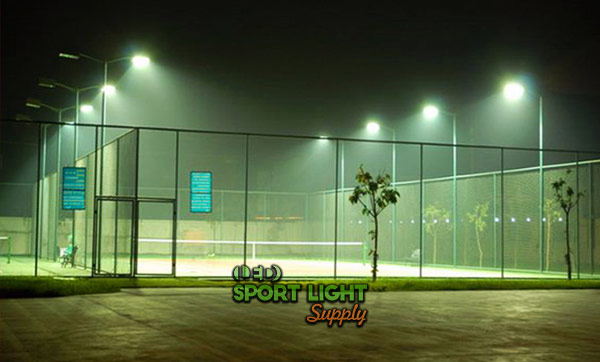 It seems that some badminton court facilities or club owners may add fences surrounding the court to block-out light leakage. These fences can be as high as 2-4 meters tall from a basic layout. While most people find this ideal for the sake of privacy or security, the real reason is to reduce light pollution. So as a general method of reasoning, you can use smaller beam angles to control the light spill.
It seems that some badminton court facilities or club owners may add fences surrounding the court to block-out light leakage. These fences can be as high as 2-4 meters tall from a basic layout. While most people find this ideal for the sake of privacy or security, the real reason is to reduce light pollution. So as a general method of reasoning, you can use smaller beam angles to control the light spill.
This is because narrow beams have less pronounced bleed-off of stray light. There’s just no room for this light to spread upward or outward. Large beam angles can be as much as 45 degrees but not any higher. Whether these lights are mounted on light poles surrounding the court or mounted onto fence poles is your decision. Smaller beam fixtures can be mounted onto any pole bracket, replacing the need to install lighting poles.
The fences can have protective covers that allow airflow but will reduce the light glare that may distract others.
What are the Lux and Lumen requirements for badminton court lighting?
1. Recreational / Badminton club
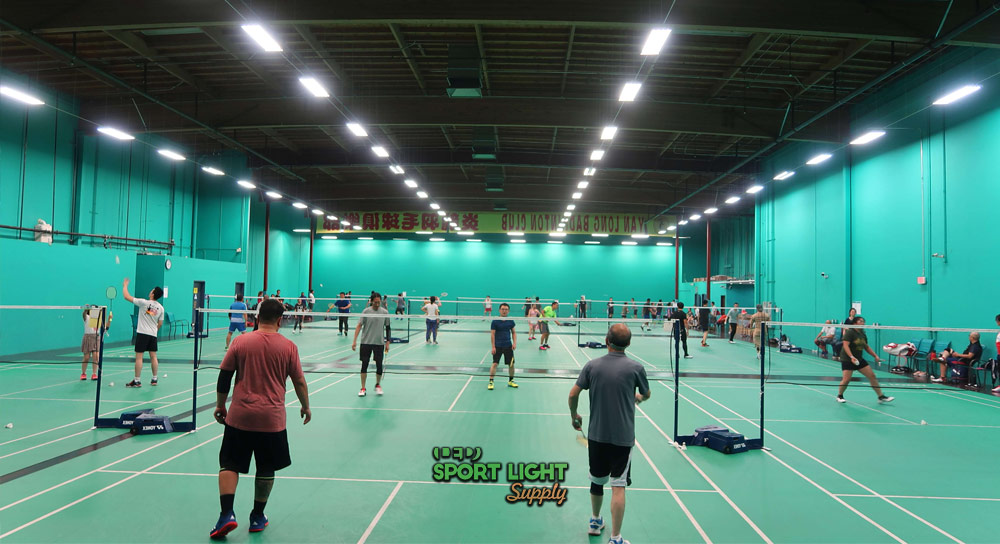
The overall Lux level for a recreational badminton court gives you 200-300 Lux on average. This accounts for as much as 200-300 Lumens coverage in a square meter area. While this doesn’t sound like much, it’s enough lighting available for casual play and not any serious competition. If this is translated to LED wattage, this amount would be considerably low wattage per fixture. Not only is this a very ideal amount of electricity that’s used outdoors, but cost-savings are also optimal.
In this configuration, it’s easy to assume that 4 lights can be placed at each corner of the court. If this is intended for a club, more light can be imagined and still keep the lighting Lux level minimal. This amount of light is very relaxed and would be considered a perfect amount for casual badminton players. It can also translate well for indoor courts since this level provides ambient lighting to see more than enough detail.
2. High school, College or Training
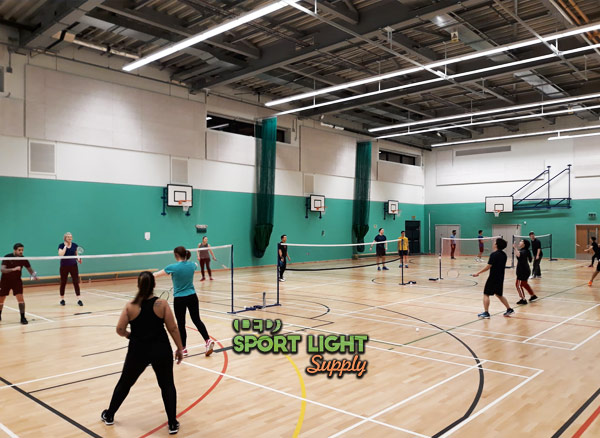 For training purposes, the amount of Lux for high school and college level is 300-500 Lux. This can be converted even further into the correct amount of Lumens. This is further defined as being 300-500 Lumens per square meter. This is a better improvement so players can see much more detail than recreational lighting will do. This also allows matches to allow spectators to view matches with a comfortable lighting level that isn’t too under lit.
For training purposes, the amount of Lux for high school and college level is 300-500 Lux. This can be converted even further into the correct amount of Lumens. This is further defined as being 300-500 Lumens per square meter. This is a better improvement so players can see much more detail than recreational lighting will do. This also allows matches to allow spectators to view matches with a comfortable lighting level that isn’t too under lit.
For this amount of lighting, you’ll want to have a standard 4 corner configuration with added sidelights. This can include the 6 to 8-pole lights layout so it better suits training light levels and removes possible player shadows. The amount of watts used for a 500 Lumen light is still minimal and cost-effective for schools and training centers. This works well for indoors and outdoors as a requirement where training and local competitions are played out.
3. Community
There are always local and state badminton teams that need a semi-pro court to play their matches on. This is why the level of lighting needs to be 500-700 Lux for higher efficiency. This is now a lighting design that demands 6-pole or 8-pole lighting configurations. These semi-pro and professional teams need higher lighting to play under. There is also a reason that television will require coverage of these matches, so the light must be higher.
Side lighting will make up a significant addition to these courts, so 8-poles would be the optimal route. Indoor facilities should opt to have angled side lighting to remove shadows caused by overhead flood lights. Since this lighting will be much brighter, the energy that follows will be invigorating. This translates well for both the spectators and team players on the court. With this Lux level, these courts are suitable for championship competitions on a local level.
4. National and International tournaments
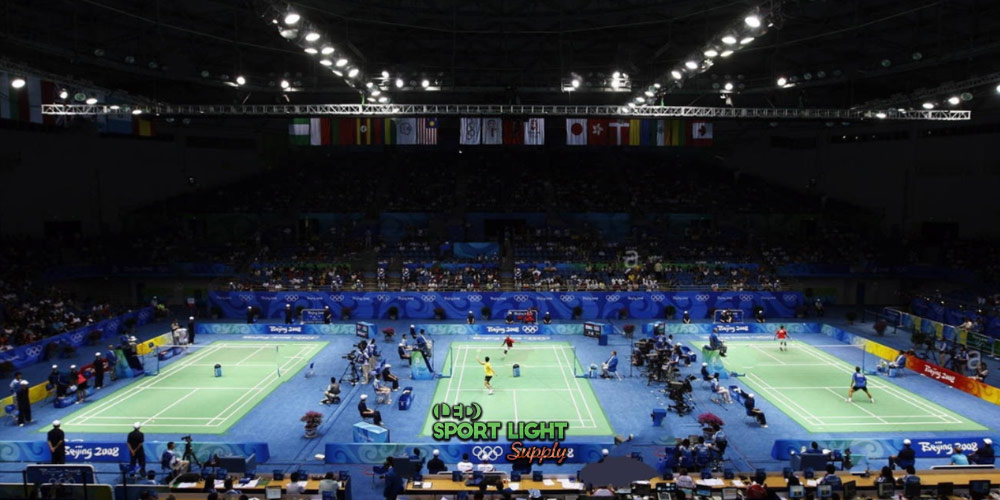
Now we get down to the bread and butter of the badminton world. These light levels are needed for matches that include BWF World Championships and Olympic Games. For this, the amount of 1000-2000 Lux is an absolute must. Because the Lumens required are delivered by tall mast lights on outdoor arenas, there is expected light loss. In reality, there is a conversion that allows for distance and height.
We need to compensate for the light loss by adding more Lumen to keep court levels having correct uniformity. These measurements are adjusted slightly depending on the height and distance. In this case, side lighting will have more fill-in lights so that TV cameras will have the cleanest image possible. This also enables the slow-motion capability using LED lights. The images will show movement and clarity that can be studied by coaches and training.
It also will make it easier for people watching on TV at home to see instant replays.
What Wattage do I need for badminton court lighting?
If you’re curious about the wattage of LED lighting, here is a very quick overview. If you have a spotlight that represents 150 Lumens per watt, you need to make a calculation for the total wattage amount. If you need 50,000 Lumens for badminton court, that 50,000 is divided by 150; and equals 333 Watts. Now you get a clear idea of how many Watts it will take to power all of your LED lights for that court.
This will be easier to estimate what your running costs will end up being. Now as these are basic figures, so an actual estimate depends on how large your court is. Other aspects including the type of lighting used indoors or outdoors need to be specified. There is also the need to plan out the lighting design using a photometric system. This will tell you exactly what your court needs for Lumens. This is then translated into Wattage after that.
Badminton court lighting price
1. Lamp price
It costs around $0.6 to $1.5 per Watt (for LED) depending on the brand or origin of the LED lamp. One great example is 1000W LED lights that can be used for badminton courts. The light price can range between $600-1500, but you shouldn’t select cheaper lamps because they could be cheaply built. You want to make sure that anything you buy has a good warranty and will last for years.
Since LED lights are known for being long-lasting and dependable, too many copy-cat brands are flooding the market. These cheaply made LED lights aren’t as dependable and will be problematic for badminton court owners. You want to know that your lights can be repaired if anything ever goes wrong. Since this says a lot for buying from a trusted LED light source. Don’t settle for cheaper lights, since they will end up costing you more to replace them.
2. Installation costs
The outgoing cost for the installation of any new LED light setup is certainly a concern for any badminton court owner. But because this type of lighting is also considered an investment, there are long-term cost savings attached. It begins with a lower wattage that helps save money on daily lighting and usage. But one aspect is the savings that come from not having to replace the previous lights so often. Here is the exact reason why.
High-pressure sodium and filament-based lamps are massive wastes of electricity. Since they use a filament to produce light, their continual heating and cooling have a faster degree of decay. The need to change burnt-out bulbs not only adds to extra costs but contributes to a continual yearly fee. It makes these lighting fixtures costly and problematic to maintain. With LED lights, there is only the need for low maintenance at any given point in the year.
3. Running costs
One of the most significant improvements in LED lighting is the reduced level of wattage that’s used. It represents an instant saving that makes up 70-80% of electricity consumption. This in return begins a steady saving that allows you to save each month and every year. As opposed to spending thousands of dollars on running costs, it’s reduced to cost-effective levels.
On top of this, the amount of work that goes into keeping the old lights up and running is reduced too. There’s no need to have a 24/7 maintenance staff to keep these types of lights working when you need them. This is a further saving on paying for electrical technicians who are costly as it is. Now, when you turn on your court lights, you don’t need to worry about the lights warming up. They turn on instantly when they are supposed to turn on.
How to select the best LED lights for badminton court?
1. Luminous efficiency
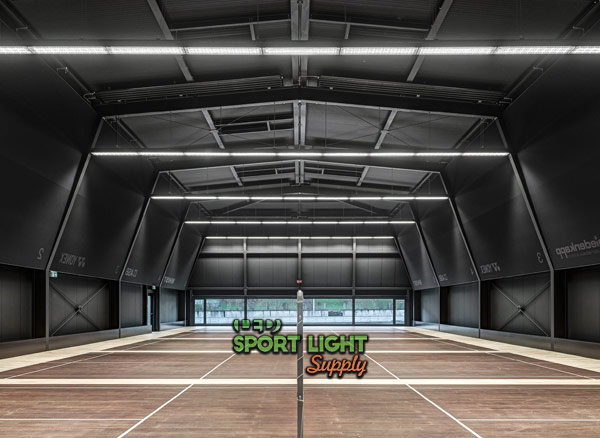 Using a new LED lighting design brings a whole development of luminous efficiency to your badminton court. The result is a cleaner and a brighter playing surface that makes any match better to play within. But it all starts with having the right amount of Lumens, color temperature, and the number of lights added. Once these have been established, the level of professional court lighting will outrank any previous lighting fixtures used before.
Using a new LED lighting design brings a whole development of luminous efficiency to your badminton court. The result is a cleaner and a brighter playing surface that makes any match better to play within. But it all starts with having the right amount of Lumens, color temperature, and the number of lights added. Once these have been established, the level of professional court lighting will outrank any previous lighting fixtures used before.
This has an appealing function that serves to expand the usage of your court in the future. There will be more interest from top badminton teams that want to switch from their practice locations for better-lit ones. This in turn can be a steady flow of business for your facility for indoor or outdoor practice. It can also be more beneficial for spectators who come and view matches when competitions are played. The best potentials start when your light is upgraded.
2. Proper beam angle
Any flood light that is pointed at a badminton court needs a proper angle to light it correctly. To do this, the height of a pole or the edges of a ceiling must be measured beforehand. This can be done through a DIALux analysis that helps determine the right angle that will cover a court effectively. Then there is little doubt when it comes time to install lights. All that is done is to repeat the same angle that the photometric study has shown.
In many cases where tall pole lights have more distance than expected, adjustments to the angle can be slight. But for that distance, the angle presents more than a few meters that may be off. With all the planning that goes into a layout study, there can always be slight adjustments that are corrected afterward. Thankfully, the number of Lumens will always be correct because the distance of tall mast lights incorporates light loss adjustment.
3. Lifespan
The best thing about LED light fixtures using flood light is that you can expect 150,000 hours of service. Unlike traditional fixtures that have a filament, an LED works differently all due to the light that’s emitted. Instead of a continual burning filament inside a gas-filled tube, thousands of micro-bursts of light are created. These bursts are so rapid that they cannot be seen by the naked eye. It takes special slow-motion equipment to see them happen.
Even at that, the top life of a fixture is increased to 20 years or more depending on the hours. Once this time is up, it might be electrical components inside the LED driver that fail first. But once an LED diode is expired, it can also be changed and the fixture is ready to work at full output once again. This makes any LED flood light worth the investment that goes into the quality behind it.
4. Color temperature
As you might already have seen with the older style of lights, you cannot change the color temperature. But with LED lights, these can have special Kelvin levels that are ordered to suit the right kind of requirements. Anytime a professional match is played, you’ll need 5000K for competition lighting. This level is a brighter white than used for practice courts. At the recreational level, it’s more common to see lower Kelvin in the 4000-4500K range.
But for the bigger events when television cameras need excellent light levels, that’s when 5000K is required. This brings out colors and details that are easier to spot without the light being too harsh. It also makes the players and action on the court visually stand-out so TV cameras can capture the images clearly. Now that HDTV is more common, adding high Lux and CRI levels complete this balance, so lighting is never uncomfortable.
5. Heat dissipation system
LED lights use a different cooling design than other types of lights. The cooling vents that come from the back of the fixture draw heat away from the semiconductor panel. This would otherwise get very hot. This cooling design uses metals that have very good heat dissipation abilities. This is why the LED fixture can cool-off faster than other lights. The light that comes from the LED fixture itself is not hot at all.
So any heat that rises from a fixture quickly dissipates and rises away from the light fixture itself. The result is a cleaner and highly efficient cooling system that allows your lights to last longer. There is less need to use air conditioning with light fixtures are used indoors. This helps reduce running costs as a result.
6. Modular design
The newest designs in LED flood lights make it easier to handle part replacements. In most cases, a repairman can take out the broken part and replace it in 10 minutes. Using identical parts that go with a LED fixture, should always be a part recommended by your LED lighting supplier. This way, there is no mistake that it allows your fixture to continue working without trouble. If your lights come with a warranty, these fixtures cover manufacturing defects.
But it’s not uncommon that LED diodes can be defective if they come from low-quality factories. You’ll find that the cheaper LED fixtures cannot allow replacement parts making it more expensive to replace an entire unit. If you intend to have long-lasting LED light fixtures, they need to be serviceable first.
7. Waterproof features
It’s not such a common thought that outdoor lights are going to be under heavy rainy weather all the time. This is especially a big issue when it comes to installing outdoor badminton court lights. But weather changes that include scattered showers or annual rainfall are to be expected. You need to think ahead and plan for the worst when it comes to moisture and water damage. LED lights do have IP ratings that protect the light fixture from the water.
Each level is rated to stand a certain type of weather and include IP65, 66, and 67. The lowest on this list is IP65, that’s good for very low rainfall. If you choose IP67, this is the best level that is meant for very rainy weather all the time. A general all-weather version is IP66, which is good for moderate to semi-heavy weather conditions.
8. Height
There is one matter that’s a top concern for LED lights, and this issue is with big flood lights on tall mast poles. These poles need to be able to handle the weight. A heavier flood light fixture may need higher installation costs to ensure that the mast poles are steady enough. When more flood lights are used, the bigger a mast pole needs to be. LEDs are constructed from semiconductor panels, which tend to be heavy.
This shouldn’t be a problem if your mast poles are rated for a specific weight limit. But if your outdoor field is in a windy area, you’ll need to install poles that will limit pole sway. These are precautionary concerns so you don’t have poorly mounted pole lights toppling over from a wind storm. Aside from the price of a bigger and stronger pole, you’re also ensuring the lifespan of your flood lights even further.
Where can we buy badminton court lighting in India?
With much of the world advancing through the internet, distant countries can get products delivered to them easily. But in some parts of the world, you might wonder how common are delivery systems in India? Thanks to global giants like Indiamart and Amazon, these online dealers give higher access to specialty items too. If you’re looking to buy badminton lights to install on a court in India, this is good news.
Several types of LED flood lights can be found on Amazon.in and trusted companies like Philips too. Their new lines of indoor LED floodlighting are some of the bigger advances you’ll find. Of course, as with everything else sold on Amazon, you want to read the reviews before you buy anything. This tells you if their LED products are built well, and look for the common problems that come up. Reviews also tell who are the Indian-givers…
Indoor & Outdoor badminton court lighting standards
1. Lux standard
The lux standards all change depending on court usage. It starts with general courts that allow 300 Lux but as a rule, 200-300 is accepted. The next level is high school and college which now allows 300-500 Lux. This is variable depending on the number of lights used or the number of spectators. Community courts meant for semi-pro and professional training are set at 500-750 Lux. Once again these will be variable depending on the usage.
The highest levels are reserved for National Championships and Olympic games which use 1000-2000 Lux. When these are inside large stadiums the light levels become increasingly bright for the media coverage and spectators. This level of light is not seen by the other categories since it’s reserved for professional championship match levels only.
2. Lighting uniformity requirement
When the discussion of lighting uniformity comes up, many of us are puzzled about what this means. To make it simple for everyone to understand, it’s the measurement of light from both vertical and horizontal positions. These are calculated together and represent how uniform light is from the top and sides of the court. It starts on the recreational levels up through the professional championship range.
You’ll find that a rating of 0.5 is for recreational, and 0.7 for professional/international tournaments. These include Lux levels starting at 300 up toward 2000 Lux. When Olympic levels are reached it must be 0.8 for HDTV lighting. But for the most part, your badminton court won’t need to exceed 0.7 for lighting uniformity. Recreational courts aren’t any lower than 0.5 but will have some uniformity issues due to basic light coverage.
3. Color temperature standard
Color temperature was an issue in the past that was dictated by the type of flood light that you purchased. These lights were either too bright or hard to control. With LED lights, color temperature can be a specific shade on the color chart. Starting on the lowest part of the scale, you can expect that recreational courts will be 3500-4000K. As the level of competition goes up, so does the color temperature.
Semi-pro and professional courts will have 4000-4500K for better clarity and sight. When it really matters most, the color temperature is 5000K for all the bigger tournaments. This is considered the High noon lighting and it quite bright. Anything brighter than this is uncomfortable for badminton players and spectators. Those brighter light levels are best reserved for excitable sports like soccer and football.
4. CRI and TLCI
There has recently been a lot of discussion on this matter when it comes to the color rendering index. In reality, the TLCI is more recent and is known to many in the TV and film industry. It’s called the Television Lighting Consistency Index and is used to measure the quality of light based on the rating only. CRI is set to a scale of 0-100 and tells you how much light is present for light reading.
At the top of the scale, 100 is considered the best while 85-90 is still acceptable. TLCI takes this one step further and rates blocks of numbers that need work or are acceptable. A rating of 50-75 is not so good but needs work to be worth consideration. 75-85 is good but may need some color correction work. And 85-100 is considered the top level with no corrections needed at all.
5. Glare
The issue of glare has always been a problem for outdoor floodlights. These massive lights sit atop light poles and can be uncomfortable to look at. Not only that, if they aren’t focused correctly, there is surely a flare problem. To fix this, these lights will have light shields that try to correct light beams. Now when using LED flood lights the beam angle can be determined beforehand, so this light direction is narrowed.
This will mean that there is less light that escapes from the fixture and is seen by spectators. As the beam angle begins to grow, it doesn’t move past its target on the ground. What spectators end up seeing are floodlights with no visible glare showing. This is why LED lights are better for removing glare and annoying light bleed.
6. Flicker-free
One problem that the earliest LEDs had was the flickering effect problems. Even with home video cameras, you could see the red light on remotes, clocks, stereo, and electrical products flashing away. That was more than 30 years ago and times have changed. Now, the power of LED light allows flicker-free results. Although LEDs do flicker, the rate is so rapid it cannot be seen unless special high frame speeds are used.
This doesn’t affect HDTV cameras using slow-motion to slow down instant replays. The effect is so fast it will appear as a black frame otherwise. These frames are removed using automatic editing software and are never seen by TV audiences. To give you an idea of how rapidly this flashing is, flicker-free LED lights to flash 250,000 times per second.
7. Instant on/off
The old sports lights that all use a filament bulb took time to warm up. This cost extra electricity and time, so any match had to have the lights running long before the players show-up. The advantage of LED lights is perfect for having instant access to lights at any time. There is no warm-up time needed as these lights come on with full intensity each time. This is an advantage if there’s a power outage too.
If the power goes off, the LEDs can be run on a backup source of battery power. There might be a second of light loss, but the lights will appear to be running at 100%. The older lights would not be able to restart so quickly and would take time to cool off. Once they got cool, the lights could be restarted taking as much as 15-20 minutes to get bright again.
Why using LED flood lights in badminton court?
There is a very simple reason why you should use LED lights over HID or HPS fluorescent. It has everything to do with energy-savings and cost reductions. It also upgrades badminton lighting to professional levels that are easier to manage over HID and HPS light fixtures. Heat issues are solved and less air conditioning is used indoors as a result. This further reduces outgoing costs for holding badminton matches.
It also makes your facility more appealing to professionals who enjoy higher light levels. With improved ability to see, a team can manage their match with a strategy that allows them to compete better. All of these reasons are more than enough but the most important is the long-term savings you get each year. This allows you to hold onto the amount that was used for paying-out for older and more expensive lights.
Common mistakes when planning the badminton court lighting
1. Omit the badminton court lighting specification
Perhaps you made the mistake of buying the wrong lights. These are the ones that have improper beam angle, power, or Lumens. It will take even longer to return them in time or have to wait if they are on backorder. Not paying attention to the kind of light that you need at your court will be a costly mistake. It might have been because of pressure to replace lights in the rush of things and not doing research first.
It’s not so bad if your LED lighting dealer has replacements on hand if these are in stock. You might have to pay after cost differences for the right lights. Some people still don’t know that LED lights have different Lumen to Watt conversions.
2. Wrong installation height
One big mistake is not estimating the amount of power that LED lights can have. This can create a bright spot on one section of the court. While ordering too little can lower the lighting uniformity. This also has a lot to do with the LED light angle. If you ordered a wide-angle of 120 degrees on a high ceiling, this will have too much light glare. The same would ruin the lighting with 20-40 degrees on a low ceiling.
It would make it nearly impossible to light-up a court due to such a focused light beam. These problems can happen without making a lighting plan beforehand. The worst part is when these services are offered for free and are turned down by their professional light experts. What results later is an angry customer who blames the lighting equipment.
3. Wrong projection angle when installing the outdoor badminton court light
Outdoor lighting is not as easy as you think it is to point and angle pole lights. A slight angle difference can create a mass change if there is a slight elevation. To know how to fix this, you need to use a laser pointer. This is so the light can precisely point to the specific area. There is also the distance of the pole from the court and the overall height of the pole. Even when these are calculated in a photometric analysis, there can be slight differences.
There is also the eventual loss of light intensity that reaches a court. This is countered by adding more Lumen to reduce this loss so that uniformity levels are achieved. A bad lighting job will result in a field that has bright and dim spots. Uniform lighting can provide a blanket of light across the whole field surface.
4. Select the badminton court lighting with the cheapest price
There are always cheaper brand flood lights that seem like a great idea at the time. That’s until there’s a problem with the light fixture. It’s a risk to take a chance with cheaper lights that can fail at any point. The entire unit can also be a fire hazard if it uses low-cost parts used for cooling vents. What is more frustrating is trying to get an overseas supplier on the phone and they don’t respond at all.
Or the light fixture you bought cannot be repaired at all, making it necessary to replace the entire light. Quality LED light fixtures can be cheaper, but the amount of risks isn’t worth the hassle. Don’t fall for a deal that might save you money in the short-term, LED lights should be built to last. These are the ones that have serviceable and repairable housings.
5. You ordered the wrong color temperature
What sounds like an ideal color temperature ends-up being too bright to handle. This is another mistake when ordering lights from online suppliers. Even a website like Amazon makes mistakes in sending out the wrong fixture from time to time. If you ordered a temperature that’s too bright, you need to replace it immediately. Anything above 5000K is going to be uncomfortable and annoying to players or spectators.
The same applies to lights that are below 3000K as the light gets progressively warmer. While it might be good for ambient lighting in your home, it’s terrible for a badminton court. Always stick to 3500-4500 depending on the level your court is meant to appeal to. The higher the Kelvin is set, the more professional the light will appear.
6. The lights are flickering and fading more often
Bad LED fixtures bought from eBay or Amazon that starts flickering after a week or two is a very bad sign. This means the internal LED driver is failing and will stop working pretty soon. It’s best to replace these lights and start looking for a quality brand instead. One that has a fixture that can be serviced easily and replacement parts put in. The better quality LED fixtures will allow electrical parts and their semiconductor diodes to be swapped-out too.
Most of the cheaper fixtures aren’t built to let you get inside them so easily. You may end up sending a fixture back to their factory while a new one is sent to you. This isn’t a good way to keep your lights running when you need continual court lighting.
Badminton court lighting FAQ
1. Where should flood lights be placed in badminton courts?
a) Indoor
Inside a building where lights can be hung from the ceiling is the most logical method. You can use UFA LED spotlights that hang downward. For this, you need to know the measurement of the ceiling so the correct angle beam can be decided. Taller ceilings need narrow beams while lower ceilings need a wider beam. There is also going to be a need for angled wall light used for filling in shadows.
If this badminton court is used for professional or community teams, you’ll want to add fill-in lighting. This is the same effect that is meant for 6-pole or 8-pole court lighting configurations. But instead of being pole-mounted, these lights are mounted on the upper sides of the walls. If it’s only for recreational use, you only need overhead lights.
b) Outdoor
Any outdoor court will need poles mounted at the edges of each corner outside the boundaries. The height can start at 20 feet with the lights angled downwards to cover one corner across to the next. As all four lights converge over the surface, this will give a court an even light covering. For more serious levels of badminton, more light poles are added on the sides. These can include 1-2 extra light poles along the sidelines.
These lights add more light uniformity and fills-in coroner light shadows that can fall on players caused by the corner lights. These added side lights make a brighter playing surface that makes it easier to see everything. It’s also preferred by the semi-pro, community, and professional badminton players who need higher light levels.
2. How much does a single badminton court flood light cover?
A single beam for a flood light ultimately forms a circle if you point it onto a wall. This circle has a diameter of 15-30 meters depending on the beam angle of the badminton court light. But because of the installation height, the circle will grow or shrink in size. The angle of the projection can make the circle distort its’ shape also. This is why corner lighting from outdoor poles is more complicated.
Consecutive oval shapes are overlaid within a court and often need extra lights added to fill-in dim spots. Overhead lights used for indoors are more like a blanket that adds spots to light up a court. Depending on the number of overhead flood lights, you might add side lighting to improve the reduction of overhead shadows.
Conclusion
In many ways, badminton lighting is very similar to tennis lighting configurations. The Lux levels can slightly be different as can the amount of Kelvin used for competition games. Because these two are both played on a court, the size of each court will be different as well. There can also be interconnected courts side by side, meaning that lighting will need to be configured accordingly.
Since no two courts are the same, we can help you to arrange your court layout for a specific number of lights and appropriate angle calculations. We offer free DIALux lighting analysis to improve the lighting layout. This ensures that any lighting setup that you need is developed ahead of time to make the installation hassle-free and easier to manage. If you have any questions at all about making your badminton court lighting layout more professional, just ask us.
We have plenty of advice that’s been used to light-up plenty of badminton courts just like yours. We also hope this ultimate guide has helped you to understand more about LED court lights.

